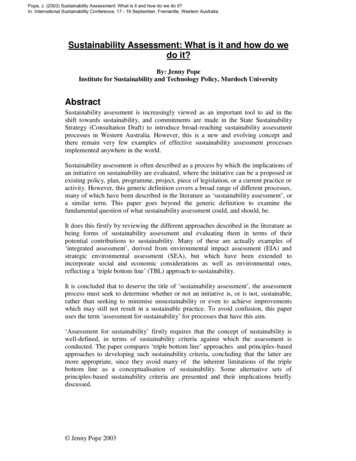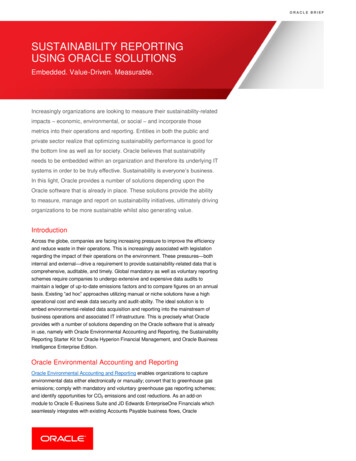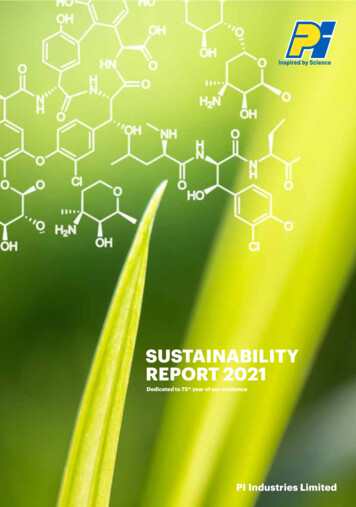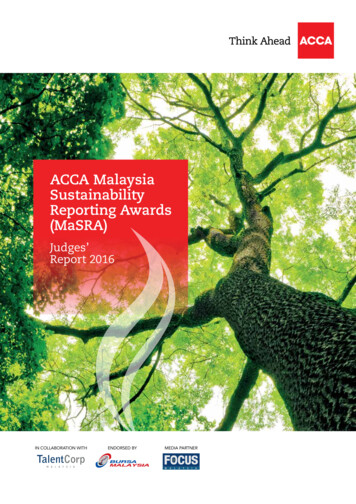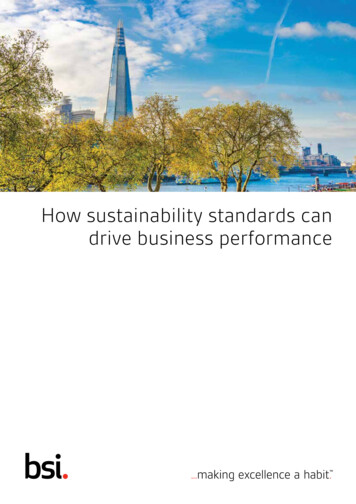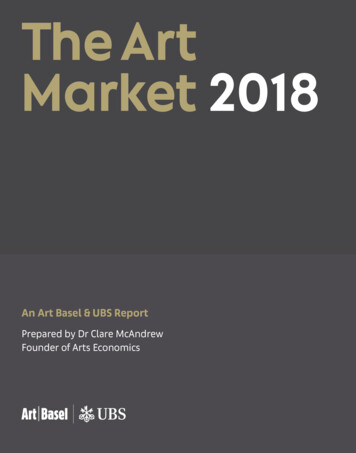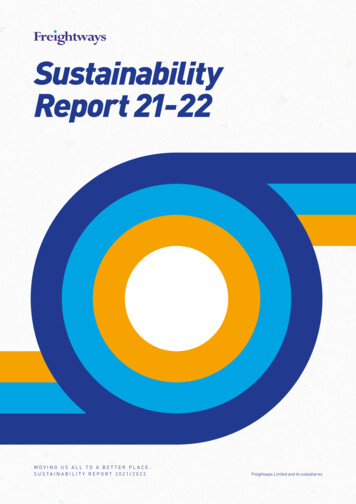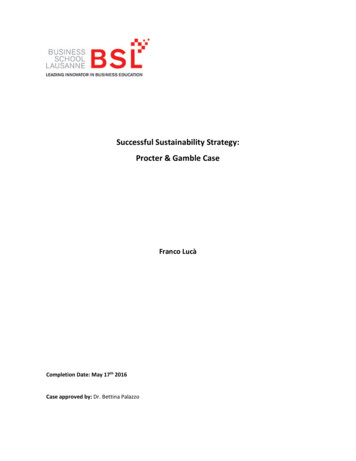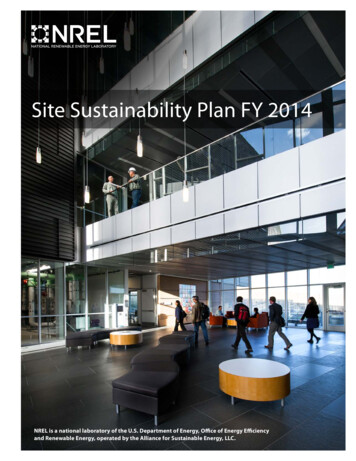
Transcription
BUSINESS SUSTAINABILITYANDCONTEMPORARY PRACTICESBusiness Management CasesEdited By:Dr. Sanjeev BansalDr. Vijit ChaturvediDr. Tazyn RahmanDr. Parikshit Joshi
Business SustainabilityandContemporary PracticesBusiness Management Cases
Business SustainabilityandContemporary PracticesBusiness Management CasesEdited By:Dr Sanjeev BansalDr. Vijit ChaturvediDr. Tazyn RahmanDr. Parikshit Joshi
Copyright2017 by Dr. Sanjeev Bansal, Dr. Vijit Chaturvedi, Dr. Tazyn Rahman andDr. Parikshit JoshiFirst Impression: 2017Business Sustainability and Contemporary PracticesBusiness Management Cases978-81-930928-6-6Rs. 650/All rights reserved. No part of the book may be printed, copied, stored, retrieved, duplicated andreproduced in any form without the written permission of the publisher / Editor.DISCLAIMERInformation contained in this Edited book has been published by Empyreal Publishing House andhas been obtained by the author(s) from sources believed to be reliable and are correct to the bestof his/her knowledge. The author(s) are solely responsible for the contents of the articles compiledin this book. Responsibility of authenticity of the work or the concepts / views presented by theauthor through this book shall lie with the author. The publisher or editors do not take anyresponsibility for the same in any manner. Errors, if any, are purely unintentional and readers arerequested to communicate such error to the Editors to avoid discrepancies in future.Published by:Empyreal Publishing HouseGuwahati, AssamMobile No: 9999817591Email: info@editedbook.in
PrologueThe present business environment is witnessed by distinctive capabilities both disruptionand eruptive mechanics making competition and sustainability more and more volatile.This demands a unique blend of strategies and techniques to surpass and sustain in thepresent environment meeting customer’s expectation to fullest sense and at the same timeremaining competitive too.Since the ever growing competitiveness across all organizational resources are expanding,more innovative ways of running business is becoming more challenging.Understanding the relevance of these complexities and with a commitment to inculcate thebest industry practices, Amity Business School, Amity University Noida organized CaseStudy Competition based on Summer Internship completed by Students in differentcompanies “Conduit” -2017 on August 31, 2017 on the theme, “Business Sustainabilityand Contemporary Practices”.The rationale of the competition was to provide an innovative approach to students fortranslating their learnings of Summer Internship in a more analytical and practical manner.The present Case Study Book titled “Business Sustainability and ContemporaryPractices” reflects upon different business practices and managerial implications acrossdifferent sector and industry based on the theme. It will help in developing insights uponvaried practices to make business more and more sustainable and expanding.The present cases will help in providing cognizance of business contemporaries thusreinforcing effectual outcomes.Editor(s)V
AcknowledgementAny acknowledgement is incomplete without thanking greatest of all, HE, who guides,protects and nurture. Thankful to great almighty for blessing us with wisdom.Every good work is a result of relentless hard work, determination, team work and effortsby one and all supported by vision of seniors and excelled leadership. The aim of thepresent book is to provide a wider platform to conceptualize, understand and incubate thecompetitive environment in which business is run fuelled by stiff competition, risingexpectation, technological support, immense innovation and customer’s varying demands.In such a situation deliberating and coming out with an enriched strategy andbenchmarking the best practices becomes imperative.We the organizer(s) of the event Conduit thankful to Hon’ble Founder President Dr.Ashok K. Chauhan Sir for his continuous blessing, inspiration and motivation.Our Sincere thanks to Hon’ble Chancellor, Dr. Atul Chauhan whose insightful vision andinnovative bent of mind helps in espousing creativity with accountability values. We aredeeply indebted to respected Vice Chancellor, Prof. (Dr.) Balvinder Shukla for hercontinuous encouragement, exemplary leadership and motivation to organize all suchevents.We are thankful to our industry experts who spent their valuable time and shared theirkeen insights which benefitted students boundlessly. We are thankful to the relentlesssupport exerted by each Faculty guide for their valuable time and expertise in making thecase worthy.Our thanks to each participant who worked persistently and participated in the event.Our sincere thanks to the relentless cooperation, support and suggestions of Team IndianAcademicians and Researchers Association to help us this project come in form of a bookmaking it learnings forever.In the last but not the least we are thankful to our family members for their unconditionalsupport.Editor(s)VI
About Editor(s)Dr. Sanjeev Bansal is Dean FMS & Director of Amity Business School, AmityUniversity Uttar Pradesh. In an acclaimed career span of about 28 years inteaching, research and consultancy, he has been invited to be a part of severalprestigious academic / professional bodies and in his advisory capacity, hassteered them to success.He is an avid researcher and has more than 150 research papers in prestigious journals to hiscredit.He has authored 26 books and has guided several research scholars to produce works ofimmense educational impact.Apart from his areas of specialization, he also likes to explore and research the vistas ofspirituality, management and quality of work life. During his distinguished career he has had manyaccomplishments and is hailed as an institution builder, a loved teacher and an ardent researcher.Dr.Vijit Chaturvedi is currently working as Associate Professor, AmityBusiness School, Amity University, Noida. She holds Doctorate from AgraUniversity, M.Phil in Management, MBA (HR) and an accredited trainer fromISTD, New Delhi. She also holds a Diploma in Labour laws. She has more than16 years of work experience in Academics and Corporate.She has contributed various papers in National and International Journals which are Globallyindexed with impact factor. She has also contributed many Book Chapters. She has participatedand has presented papers in many Conferences, seminars and workshops at national andinternational Level. She also got the Best Paper Award (Women’s Category) for her paperpublished in October Issue 2011 in IJTD published by ISTD, New Delhi. She has successfullyconducted many MDP’S and FDP’S in various areas of Management in PSU’S.She has 2 Books to her credit on Talent Management: System and Strategies and ContemporaryPractices in Business Management. Her Research areas include Leadership, OrganizationCommitment, Competency Mapping, training need identification and evaluation, Talentidentification and employee engagement.She is a member of National HRD network (NHRD), Indian Society of Training and Development(ISTD), AIMA, Indian Academician and Researchers Association (IARA).Dr. Tazyn Rahman is Associate Professor & Head Scholar's Program atInstitute of Management Studies (IMS), Noida with close to thirteen years ofexperience in academics and industry. She holds a Ph.D. in Commerce from CCSUniversity, Meerut and M.B.A with specialization in HR and Marketing fromGauhati University. She was also a Programme Director of ManagementDevelopment Programmes in “ Brand Management” conducted by JaipuriaSchool of Business, Ghaziabad.She is the Editor - In - Chief of International Journal of Research in Management & SocialScience published by Empyreal Institute of Higher Education, Guwahati which is an UGCapproved journal. She has been conference convener of many international conferences. Herresearch interests are focused on Strategic Human resources Management, Entrepreneurship,VII
Marketing with a focus on emerging markets. She has published /presented /contributed more than50 research papers in various National and International Journals and conferences. She hasprepared study materials in Organisation Structure and Design, Marketing Research, Productionand Operations Management for a leading Management InstituteDr. Parikshit Joshi, an engineering graduate with postgraduate in HumanResources, is Assistant Professor in Amity Business School, Amity UniversityUttar Pradesh. Dr. Joshi has an academic experience of more than 10 years. Hisarea of interests are Human Resource Analytics, Decision Science, WorkplaceSpirituality and Supply Chain Management.Dr. Joshi an IIM Ahmedabad Alumni is also a certified trainer from Infosys and has presented hiscandidature at various national and international academic platforms. Also he has published morethan 30 research papers in various national and international journals.VIII
LIST OF CONTENTSPrologueVAcknowledgementVIAbout EditorsVII - VIIIList of ContentsIX - XIIPart – 1: Marketing Management1SOLAR POWER: SUSTAINABLE SOLUTION TO INDIA’S ENERGY NEEDS2–6Sanjit Singh Lamba and Ms. Shinu VigBORROW VITAMIN-M - MARKETS7 – 13Aditi Gupta and Dr. Aparna GoyalSTRATEGIES TO BE IMPLEMENTED TOWARDS VENDING BUSINESS14 – 17Akansh Singhal and Dr. Jaideep KaurTHE BEHAVIOR OF CONSUMERS AND RETAILERS TOWARDS THE, PURCHASE OF KARAPRODUCTS18 – 24Ashima Gupta and Prof. Akhil SwamiMARKET PENETRATION OF KARA NAIL POLISH REMOVER WIPES25 – 27Ayush Abhay and Dr. Rushina SinghiFORD INDIA: DIGITIZING THE CONSUMER DECISION JOURNEY28 – 36Hansika Talwar and Dr. Varsha KhatrriIMPORTANCE OF DISTRIBUTION SYSTEM IN CEMENT INDUSTRY37 – 41Kritika Bagga and Dr. Shweta AwasthiBUSINESS KETING42 – 44Manpreet Kaur and Mr. Hargovind KakkarWIPE MARKET TURNING UP AND DOWN45 – 48Minal Soni and Ms. Ruchika NayyarDIGITAL MARKETING AND OPTIMIZATION OF WEBSITES AND CHALLENGES FACEDBY DIGITAL MARKETERS49 – 55Nikita Nambiar and Dr. Jaya YadavCHALLENGES IN SALES & PROMOTION OF KARA NAIL POLISH REMOVER56 – 58Rupayan Biswas and Dr. Himani SharmaASIAN PAINTS: JOURNEY TOWARDS BECOMING A PAINT GIANT59 – 62Saumya Mittal and Dr. Anurupa B. SinghIX
IMPACT OF MARKETING STRATEGIES ON CARS2463 – 67Shivangi Agarwal and Dr. Supriti AgarwalA CASE STUDY ON BARCODE SCANNING: OPERATION ASSISTANT PRODUCTIVITY68 – 72Shivangi Sharma and Prof. Akhil SwamiCUSTOMER RELATIONSHIP MANAGEMENT73 – 76Shubham Mittal and Dr. Sumeet Singh JasialONLINE BANKING AND E-CRM INITIATIVES: A CASE STUDY IN RETAIL BRANCHBANKING77 – 81Siddhant Chawla and Dr. Rushina SinghiDIGITAL E-WALLETS82 – 85Suruchi Singh and Dr. Aparna GoyalCUSTOMER SATISFACTION AT FORD MOTORS86 – 90Vibhuti Garg and Dr. Aparna GoyalSMART WAY TO MANAGE SCHOOLS WITH A CLOUD BASED ERP “RADICAL LOGIX”91 – 94Swati Gupta and Prof. Ramesh Kumar BaglaPart – 2: Finance ManagementPERCEPTION OF INVESTORS TOWARDS DERIVATIVE MARKET9596 – 100Shreya Rastogi and Dr. T. V. RamanGLOBAL SERVICE MANAGEMENT CENTRE AT ACCENTURE101 – 104Aayesha Mathur and Ms. Shinu VigFINANCIAL AID PROVIDED BY THE BANK TO THE CUSTOMERS105 – 106Akshita Bahuguna and Dr. Anurupa B. SinghPORTFOLIO MANAGEMENT SYSTEM AT SMC GLOBAL SECURITIES LTD107 – 111Alisha Bansal and Dr. Jaya YadavMAKE DREAMS FLY!!112 – 115Anwesha Patra and Dr. Rahul GuptaSECURED TIL ETERNITY116 – 122Aprajita Arora and Mr.Vivek Singh TomarA CASE STUDY ON WORKING CAPITAL MANAGEMENT IN LG INDIA PVT LTD123 – 125Ashish Garg and Dr. Supriti AgarwalCHALLENGES AND ISSUES RELATED TO GST126 – 128Deeksha Wadhawan and Dr. Smrita SinhaX
THE SUCCESS STORY OF ADVANCE PRICING AGREEMENT129 – 132Guntas Kaur and Dr. Mansi PaulWORKING CAPITAL MANAGEMENT OF JAGUAR LAND ROVER133 – 135Rashi Khandelwal and Dr. Shweta AwasthiIMPACT OF GST ON HONDA CARS INDIA LIMITED136 – 140Sambhav Mehta and Dr. Jaya YadavIMPACT OF GST ON MOTHER DAIRY141 – 145Shivani Kaushik and Dr. Supriti AgarwalNBFC: ITS CHALLENGES AND SOLUTIONS146 – 148Shivika Garg and Dr. Anu PrashantMUTUAL FUNDS SIMPLIFIED, A SIMPLE AND EASY WAY OF INVESTMENT INMUTUAL FUNDS THROUGH ICICIDIRECT.COM149 – 156Taran Preet Singh and Dr. Anita VenaikCASE STUDY: THE CURIOUS CASE OF HDFC N-47157 – 159Yasha Porwal and Mr. Hargovind KakkarTHE EFFECTS OF DEMONETIZATION ON SURYA BUILDERS & BUILDERS (REALESTATE SECTOR)160 – 163Shubhi Garg and Dr. Mansi PaulPORTFOLIO CONSTRUCTION - HUMAN ADVISORY V/S ROBO ADVISORY164 – 168Shubhangi Khurana and Dr. Manjula ShastriPart – 3: Human Resource ManagementIMPLEMENTATION OF MINIMUM WAGE REGULATION AT RITES LTD.169170 – 172Antara Choudhary and Dr. R. SujathaPROBLEMATIC TRAINING173 – 174Ankita Sengar and Dr. Anshu YadavWHAT TATA AIA LIFE INSURANCE COMPANY MIGHT BE LACKING175 – 177Parul Priya and Dr. Varsha KhattriEMPLOYEE ENGAGEMENT AT RALSON (INDIA) LIMITED178 – 179Pavit Bhogal and Dr. Anshu YadavSTUDY ABOUT EMPLOYEE COMMITMENT IN LG ELECTRONICS INDIA PVT. LTD180 – 182Rashmi Kaushik and Ms.Sonali P. BanerjeePROBLEM OF ATTRITION AT LIFESTYLE INTERNATIONAL PVT. LTD.183 – 186Ritiksha Srivastava and Dr. Puja SareenXI
RECRUITMENT CHALLENGES – A CASE ON TATA AIA LIFE187 – 190Sakshi Arora and Dr. R. SujathaALUMNI ENGAGEMENT IN KPMG IN INDIA191 – 195Swati Kumar and Dr. Harminder Kaur GujralCOMPENSATION PLAN: A TRIGGER FOR EMPLOYEE MOTIVATION196 – 198Mahek Bisht and Dr. Shikha MishraPERFORMANCE APPRAISAL: A DIFFERENT PERSPECTIVE199 – 204A. Renuka and Ms.Sonali P. BanerjeeXII
Business Sustainability and Contemporary PracticesPart – 1Marketing Management1
Business Sustainability and Contemporary PracticesSOLAR POWER: SUSTAINABLE SOLUTION TO INDIA’S ENERGY NEEDSSanjit Singh Lamba1 and Ms. Shinu Vig2Student - MBA (General) and Assistant Professor2, Amity Business School, AUUP, Noida1ABSTRACTIt is just one-time investment and minimum care and since it is not CFL but LED light with solar panelwhich makes it more efficient because of the coating used in the CFL which helps in reflecting the lighttowards work area and only 20% amount of light is generated as heat and which cannot be used for theroads. Through this case study it was found that India has a great potential for solar energy. Also, got toknow the national action plans taken by government to promote solar energy in India and most importantly,the future scopes of solar energy in India.Keywords:Solar Energy: radiant energy emitted by the sun.Solar Panels: a panel designed to absorb the sun's rays as a source of energy for generating electricity orheating.LED Lights: An LED light bulb is a solid-state lighting device that fits in standard screw-in connectionsbut uses LEDs (light-emitting diodes) to produce light.Photovoltaic Cell (PV Cell): is a specialized semiconductor diode electronic device that converts lightenergy into electrical energy using various chemical and physical phenomena.INTRODUCTIONSolar energy is radiant light and heat from the Sun that is harnessed using a range of everevolvingtechnologies such as solar heating, photovoltaics, solar thermal energy, solar architecture, molten salt powerplants and artificial photosynthesis.It is an important source of renewable energy and its technologies are broadly characterized as either passivesolar or active solar depending on how they capture and distribute solar energy or convert it into solarpower. Active solar techniques include the use of photovoltaic systems, concentrated solar power and solarwater heating to harness the energy. Passive solar techniques include orienting a building to the Sun,selecting materials with favourable thermal mass or light-dispersing properties, and designing spaces thatnaturally circulate air.The large magnitude of solar energy available makes it a highly appealing source of electricity. The UnitedNations Development Programme in its 2000 World Energy Assessment found that the annual potential ofsolar energy was 1,575–49,837 exajoules (EJ). This is several times larger than the total world energyconsumption, which was 559.8 EJ in 2012.In 2011, the International Energy Agency said that "the development of affordable, inexhaustible and cleansolar energy technologies will have huge longer-term benefits. It will increase countries’ energy securitythrough reliance on an indigenous, inexhaustible and mostly import-independent resource, enhancesustainability, reduce pollution, lower the costs of mitigating global warming, and keep fossil fuel priceslower than otherwise. These advantages are global. Hence the additional costs of the incentives for earlydeployment should be considered learning investments; they must be wisely spent and need to be widelyshared".The main objective of case study is to examine the present status of solar energy industry in India and itsfuture scope.Significance of the study will be helping getting knowledge about solar energy and the stepstaken by government to encourage solar energy in India and the behaviour and perception of people for solarenergy.KEY FACTS Capacity addition of 72,400 MW by 2022, with solar will contribute 28%.2
Business Sustainability and Contemporary Practices Government mandate for SERCs to promote renewable sources of energy. Government subsidies are provided to solar energy projects. US 41.73 billion opportunity in the solar energy market in India till 2022. In 2011, India received 2 billion funding for solar projects in 2011. (Exhibit-1)INDUSTRY INTRODUCTIONIndia's lighting market is worth US 1.75 billion, with year-on-year growth of 7.5%, and is stipulated toreach US 2.75 billion. CFL is the biggest and fastest growing segment across the Indian lightingmarketspace, accounting for 27.5% of total sales value. The CFL segment is stipulated to reach US 760million, contributing to 28% of the total domestic market. India's Government initiatives to replaceincandescent bulbs with LED bulbs, increasing energy demand supply gap and declining prices have beenleading to an increase in India's LED market, which is stipulated to reach 1,457 million by 2019, with acompound annual growth rate of 35% between 2014 and 2019.The National government's mandate of rural electrification along withusage of energy efficient formats is thecore driverof the lighting marketspace on the long-term basis (especially CFL variant). Rajiv GandhiGrameenVidyutikaranYojana and BYL programs have been implemented for the past 4-5 years, withapproximately 53% households receiving electricity and subsidized replacement of US 8.5 million ICLtechnology with CFL variants.On the other hand, the national governmentof India is the largest customer of the lighting product portfoliofor urban housing, airports, railways, and highways (NHAI). India's lighting marketis slightly consolidated,with the three largest manufacturers controlling 46% of the market share (2011). Philips is the biggestmanufacturer and distributor of lighting products with market share of 26% (2010-2011).JAWAHARLAL NEHRU NATIONAL SOLAR MISSIONThe Jawaharlal Nehru National Solar Mission was launched on the 11th January, 2010 by our former PrimeMinister, Dr. Manmohan Singh. Initially, the Mission has set the ambitious target of deploying 20,000 MWof grid connected solar power by 2022. This target was further revised to 100,000 MW in 2015. Missionwill make India a global leader in solar energy. (Exhibit-2)CONVERTING SOLAR ENERGY INTO ELECTRICITYThere are two different ways for converting solar energy into electricity:Solar Photovoltaic (PV)PV, the technology which converts sunlight directly into electricity, is among the fastest growing segmentsof the renewable energy industry. It is already well established in many countries including India, and looksset to become one of the key technologies of the 21st century. Some of the factors driving the growth of thissegment are: concerns towards carbon emissions, energy security and the rising prices of fossil fuels.Traditional solar cells are made from silicon, and are generally the most efficient. Thin-film solar cells madefrom amorphous silicon or non-silicon materials such as cadmium telluride are the second-generation solarcells, and are gaining a greater share in overall installations. (Exhibit-3)Solar ThermalSolar thermal systems harness solar energy by utilising solar radiations to generate heat- as hot water, hotair, steam etc. that can be deployed for meeting numerous applications in different sectors such as powergeneration on a large scale, space heating, space cooling, community cooking, process heating etc. Theseapplications make use of solar energy collectors as heat exchangers that transform solar radiation energy tointernal energy of the transport medium (or heat transfer fluid, usually air, water, or oil).SOLAR POTENTIAL IN INDIA India receives solar energy equivalent to over 5,000 trillion kWh per year, far more than its total energyconsumption3
Business Sustainability and Contemporary Practices Daily average solar energy incident varies from 4 - 7 kWh per sq. m. depending on the location and timeof the year Rajasthan and north Gujarat receive highest annual radiation with over 6 kWh/sq meters Andhra Pradesh, Maharashtra, and Madhya Pradesh receive radiation of 5-6 kWh/sq m (Exhibit-4)FUTURE SCOPE Irradiation data suggests that 0.5% of India’s land area under solar PV could meet all electricity needs ofthe country in 2030 Cost of photovoltaic cells excepted to decrease to around 1/Watt India is on course to become the world’s fourth-largest consumer of renewable energy, after China India’s first solar panel-fitted train is all set to commence trial runs Exhibit-4)4
Business Sustainability and Contemporary Practices(Exhibit-5)5
Business Sustainability and Contemporary Practices(Exhibit-6)6
Business Sustainability and Contemporary PracticesBORROW VITAMIN-M - MARKETSAditi Gupta1 and Dr. Aparna Goyal2Student - MBA (General) and Associate Professor2, Amity Business School, AUUP, Noida1INTRODUCTIONFrom the beginning of time, human being has been motivated to succeed in life, to amass more good andexpand his own horizons of being. For some people it meant getting a loan from a friend to return it backuntil the next harvest or until a next supply comes in. Peer to peer lending has been in existence since a longtime, though it was not called by the same name in the earlier days of its presence. Its existence has not beena rise and fall criteria rather it has been a constantly growing concept and is still being used today.Peer topeer loans are unsecured loans. They are provided to individuals rather than companies. For these loans theborrower does not have to provide any kind of mortgages or collaterals in case of default to a lender. Peer toPeer concept tends to bridge the gap between the people (consumers) who want a loan and the people whohave the capacity to fulfill this want of a loan. The peer to peer concept is a concept that dismisses the role ofthe middleman such as banks, between the needful and the lenders. And in general, it is supposed that theborrowers would get lesser rate than the banks and the lenders grow their investment at a much faster rate.The investor depending on the riskiness of the investment he is making and the evaluation of the borrower’sability to pay back chooses the lending rates. With the emergence of internet and e-commerce it is possible toabolish the traditional financial intermediaries. The emergence of the peer to peer lending platform in theform of peer to peer (P2P) lending sites have led to an increased time and cost saving and has also introducedpeople to the concept of crowd sourcing (Meaning: the practice of obtaining needed services, ideas, orcontent by soliciting contributions from a large group of people, and especially from an online ary/crowdsourcing) which opened up the lenders and the borrowers to a whole newworld of opportunities to earn and gain more profits.Peer to peer loans may have the following common characteristics "Chapter 2 Section 5: FinancialIntermediaries". Money and Banking, Retrieved August 5, 2012; 06/ECON302-1.2-1st.pdf): Conducted for faster profits There is no necessary relation between the lender and the borrower Intermediation is done by only a peer to peer lending company that provides a platform for the interactionof the lenders and the borrowers Online transactions take place Lenders have a choice of where to invest Loans are not protected by any government guarantee or insuranceOBJECTIVES Identify the scope and working of Funding Circle and Ansa-lend over the internet. Identify whether the peer to peer lending is a new alternative for short term loan industry. Critically evaluate the risks associated for the borrowers and lenders in it. Compare and contrast the business models and strategies of both the companies using SWOT Analysisand Porters 5 forces of competition. Analyse the future of both the companies by the market trends and their success charts in previous years. Recommend both the companies Content analysis of secondary data such as data obtained from the e-books, news papers,social mediaand company websites.7
Business Sustainability and Contemporary Practices Case study analysis of Funding Circle and Ansa-lend. There was a time and financial constraint because of which no primary research could be carried out.This study is to identify the new lending platform for short term borrowers and lenders over the internet. Itfocuses at the scope and forecast the success or failure of peer to peer lending companies in the market. Theresearch consists of secondary data, which provides different perspectives towards the research question.Funding Circle is one of the largest peer to peer UK based exchange for borrowing and lending money.Ansa-lend is the company operating in the same industry in India. A small overview of their business modeland working provides an insight into its system and market.Ansa-lend India’s first peer to peer lendinginitiative provides a platform for the borrowers and the lenders to facilitate a financial transaction. Itconnects borrowers and lenders in such a way that both of them derive much more benefits out of thetransactions as compared to conventional intermediaries such as banks. The site aims to provide individualslow cost loans for their minor expenses.In the Indian market, the banks offer personal loans and loansthrough credit cards on high interest rates; the repayment of these loans has become a difficult task. Theglobal economic crisis has further worsened the accessibility to credit. Through, Ansa-lend, lenders offerloans online at competitive interest rates and get good returns.Getting loans through this site depends on thecreditworthiness of the borrower and the ability to convince the lender about his need through variousrecommendations from family and friends, endorsement through groups, colleagues at workplace or anyother informal group, individual goals, needs, etc. Ansa-lend offer loans for different purposes such aseducational fees, medical emergencies, vacation, relocation, etc. Loans can be availed up to Rs. 3, 00,000(three lakhs only) and can be repaid over a period of three years.The main target of this site is the youngworking Indians who have just entered the corporate world and do not have the access to credit throughchannels such as the banks due to a very little amount of credit history.Ansa-lend work as an exchange platform for facilitating transactions. Individuals choose their terms andconditions for the transaction which is beneficial to borrowers and lenders giving a scope for negotiationbetween the parties involved which results in a fair transaction.It offers only relevant information of thelenders to the borrowers and vice-versa making the process transparent. All background checks identitycheck, verification and documentation is done by the company itself.A transaction fee of 2%-3% of loanamount or Rs. 1000 whichever is higher is charged from borrowers and 1.5% of the loan amount or Rs. 750as servicing fees is charged to lenders. Pre-closure of loans does not attract penalties. Online advertising andcross selling of other products are the sources of income for it.WORKFLOWBorrower side workflow A borrower creates and activates a personal account on www.Ansa-lend.in. Register his account providing personal and financial details. Two step verification and approval of the account is done.8
Business Sustainability and Contemporary Practices The borrower can put up his desire of the loan and its specifications such as the amount, the tenure ofloan, the interest/EMI, purpose of loan, and some evidence to convince the lenders about the loanrequest. Browse the lender listing and approach lenders or try and be approached by them. If there is one lender that is ready to lend the entire loan then negotiate the interest rate and close theloan. Loan documentation, handover EMI cheques to Ansa-lend. Ansa-lendkeeps the loan agreements inits own custody. Once the loan is paid, the documents are returned to both the partiesLENDER SIDE WORKFLOW A borrower creates and activates a personal account on www.Ansa-lend.in. Register his account providing personal and financial details. One step verification and approval of the lender via PAN card, address proof and photographs. Browse the borrower listing and approach borrowers or try and be approached by them. Negotiate the interest rate on the loan after analyzing the risk in the investment to be made. Loan documentation, handover loan amount cheques to Ansa-lend. Ansa-lend keep the loanagreements in its own custody. Once the loan is paid, the documents are returned to both the parties.Ansa-lend have followed the peer to peer to concept as a whole but has modified some of its process
Shivani Kaushik and Dr. Supriti Agarwal 141 - 145 NBFC: ITS CHALLENGES AND SOLUTIONS Shivika Gargand Dr. Anu Prashant 146 - 148 MUTUAL FUNDS SIMPLIFIED, A SIMPLE AND EASY WAY OF INVESTMENT IN MUTUAL FUNDS THROUGH ICICIDIRECT.COM Taran Preet Singh and Dr. Anita Venaik 149 - 156 CASE STUDY: THE CURIOUS CASE OF HDFC N-47
